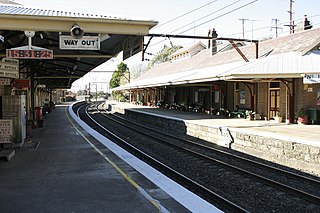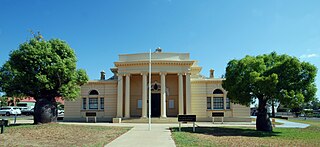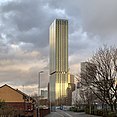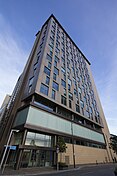
The University of Salford is a public university in Salford, Greater Manchester, England, 1 mile west of Manchester city centre. The Royal Technical Institute, Salford, which opened in 1896, became a College of Advanced Technology in 1956 and gained university status in 1967, following the Robbins Report into higher education.

Salford Quays is an area of Salford, Greater Manchester, England, near the end of the Manchester Ship Canal. Previously the site of Manchester Docks, it became one of the first and largest urban regeneration projects in the United Kingdom following the closure of the dockyards in 1982.
Penryn Campus is a university campus in Penryn, Cornwall, England, UK. The campus is occupied by two university institutions: Falmouth University and the University of Exeter, with the shared buildings, facilities and services provided by Falmouth Exeter Plus.

Mount Victoria railway station is a heritage-listed former barracks and now staff accommodation, guest accommodation, railway signal box and railway station located on the Main Western line in Mount Victoria in the City of Blue Mountains local government area of New South Wales, Australia. It was designed by NSW Government Railways and built from 1868 to 1913 by Allan McClean and James Barrie (1868 building). It is also known as Mount Victoria Railway Station group. The property was added to the New South Wales State Heritage Register on 2 April 1999. The station opened on 1 May 1868.

The Green Building is an environmentally conscious mixed-use development situated in Manchester. The Green Building was designed by Farrells, who aimed to create a sustainable environment on an unusual triangular plot, adjacent to Oxford Road station. The building was constructed by Taylor Woodrow as part of the Macintosh Village development, which was formerly a Dunlop tyre factory and also the birthplace of the Mackintosh raincoat.

The Alan Turing Building, named after the mathematician and founder of computer science Alan Turing, is a building at the University of Manchester, in Manchester, England. It houses the School of Mathematics, the Photon Science Institute and the Jodrell Bank Centre for Astrophysics. The building is located in the Chorlton-on-Medlock district of Manchester, on Upper Brook Street, and is adjacent to University Place and the Henry Royce Institute. While under construction the project was known as AMPPS : Astronomy, Mathematics, Physics and Photon Science. The building was shortlisted for the Greater Manchester Building of the Year 2008 prize, which is awarded by the Greater Manchester Chamber of Commerce. The manager of the building project was awarded a silver medal in the Chartered Institute of Building "Construction Manager of the Year" awards.

This is a list of halls of residence both on and off campus at the University of Leeds in Leeds, England.

Roma Courthouse is a heritage-listed courthouse at 141 McDowall Street, Roma, Maranoa Region, Queensland, Australia. Constructed in 1901, the courthouse is a rendered masonry building, which is still in use today. Predominately influenced by the Federation free style, it is considered a stunning example of Federation colonial architecture at its best. It is also known as Roma Court House and Roma Police Buildings. It was added to the Queensland Heritage Register on 7 August 1998.

Bridgewater Heights(also known as Liberty Heights, Wakefield Street Tower, or 17 New Wakefield Street) is a skyscraper apartment building in Manchester, England, west of Oxford Street. 17 New Wakefield Street was designed by local architect Stephen Hodder in a clustered architectural form and was completed in September 2012. The skyscraper is situated adjacent to Oxford Road railway station, on the corner of Great Marlborough Street. The skyscraper is 37 storeys high at a height of 109 metres and is the twelfth tallest building in Manchester behind towers such as Deansgate Square's South Tower, the Beetham Tower and CIS Tower.

The Swanston Academic building is an RMIT building designed by the architecture firm Lyons and is located on Swanston Street in Melbourne across from Peter Corrigan designed building 8 and ARM's Storey Hall. Construction began in September 2010 and was completed in September 2012. The budget for the SAB was $200,000,000. The new building contains 35,000 square metres (380,000 sq ft) of floor space, is 11 storeys high and provides 6 large lecture theatres for students. The colourful building is intended to reflect the cities surroundings in the façade. “The idea is to wear the ‘cloak’ of the city”.
The scissor section flat is a distinctive way of arranging the flats in an apartment block that was developed in the 1950s by London County Council Architects department. The interlocking design provides a way of maximising the space given to flats in any building volume by reducing the space needed for entrance corridors and providing a dual aspect for each dwelling. When used in high rise tower blocks, the scissor arrangement also makes the lift installation cheaper as a landing is only required every three levels. But the design does have accessibility issues and the complex arrangement has caused confusion for emergency services.

A byelaw terraced house is a type of dwelling built to comply with the Public Health Act 1875. It is a type of British terraced house at the opposite end of the social scale from the aristocratic townhouse, but a marked improvement on the pre-regulation house built as cheap accommodation for the urban poor of the Industrial Revolution. The term usually refers to houses built between 1875 and 1918.

Rockhampton Courthouse is a heritage-listed courthouse at 42 East Street, Rockhampton, Rockhampton Region, Queensland, Australia. It was designed by John Hitch and built from 1950 to 1955. It is also known as District Court, Queensland Government Savings Bank, Commonwealth Bank, Magistrate's Court, Police Court, and Supreme Court. It was added to the Queensland Heritage Register on 21 October 1992.

The Range Convent and High School is a heritage-listed private school at 263 Agnes Street, The Range, Rockhampton, Rockhampton Region, Queensland, Australia. It was built from c.1880s to 1930s. It is also known as Our Lady of Good Counsel Convent and School and The Catholic College Residential. It was added to the Queensland Heritage Register on 21 October 1992.

The Dalgety Offices is a heritage-listed office building at 1-13 Sturt Street, Townsville CBD, City of Townsville, Queensland, Australia. It was designed by Walter Hunt and built from 1923 to 1925 by William Hornby Turner. It is also known as Sunskill House. It was added to the Queensland Heritage Register on 26 August 2005.

The Oswald Bond Store is a heritage-listed former wool bond store and now offices at 1-17 Kent Street, in the inner city Sydney suburb of Millers Point in the City of Sydney local government area of New South Wales, Australia. It was designed by A. L. & G. McCredie and built by J. R. Locke. It is also known as Hentsch's Bond Store. It was added to the New South Wales State Heritage Register on 2 April 1999.

107-109 Bathurst Street, Sydney is a heritage-listed former bank building and now KFC fast food restaurant located at 107-109 Bathurst Street in the Sydney central business district, in the City of Sydney local government area of New South Wales, Australia. The property is privately owned. It was added to the New South Wales State Heritage Register on 2 April 1999.

The Clarence Street Police Station is a heritage-listed former police station and now community service office located at 281 Clarence Street, in the Sydney central business district, in the City of Sydney local government area of New South Wales, Australia. It was designed by James Barnet as the NSW Government Architect and was built from 1890 to 1928. It was added to the New South Wales State Heritage Register on 2 April 1999.

Warwick State High School is a heritage-listed state high school at Palmerin Street, Warwick, Southern Downs Region, Queensland, Australia. It was designed by Thomas Pye and Block A was built from 1914 to 1915. It is also known as Warwick Technical College and Warwick Intermediate School. It was added to the Queensland Heritage Register on 28 June 2018.
























